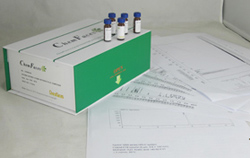Hot Products



| Catalog No. | Information |
| CFN95085 | 2''-O-acetylsaikosaponin A Reference standards. |
| CFN93096 | 2''-O-Beta-L-Galorientin Reference standards. |
| CFN95111 | 2-O-cinnamoyl-beta-D-glucose Reference standards. |
| CFN99728 | 2''-O-Galloylhyperin 2''-O-Galloylhyperin has effects on arrhythmias in an isolated tissue model of hypoxia and reperfusion. |
| CFN95046 | 2''-O-Galloylmyricitrin Reference standards. |
| CFN95041 | 2''-O-Galloylquercitrin 2''-O-Galloylquercitrin is a natural product from Acer ginnala. |
| CFN97920 | 2'-O-Methylhelichrysetin Reference standards. |
| CFN98832 | 2'-O-Methylisoliquiritigenin 2'-O-Methylisoliquiritigenin, a compound synthesized by enzymes specifically induced in NR. |
| CFN92551 | 2''-O-Rhamnosylicariside II 2″-O-Rhamnosylicariside II shows potent antioxidant activity, with IC50 values of 11.5 ug/mL and 90.5 uM. It shows potent inhibitory activities on osteoclast-like cell formation at a concentration of 2 uM without toxic effects. |
| CFN98920 | 2-Oxopomolic acid 2-Oxopomolic acid shows cytotoxic activity, it shows a significant decrease in intracellular melanin content in B16-F10 cells, and in culture media melanin. 2-Oxopomolic acid shows radical-scavenging activities similar to that of the reference antioxidant alpha-tocopherol (vitamin E). |